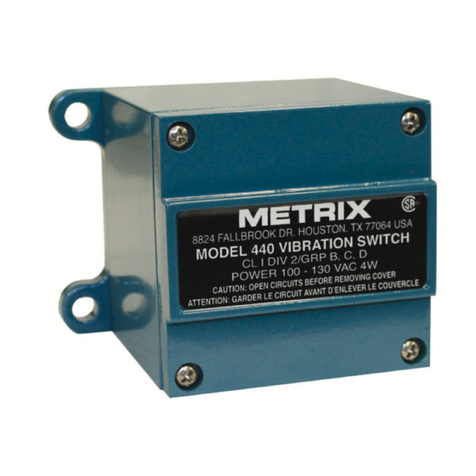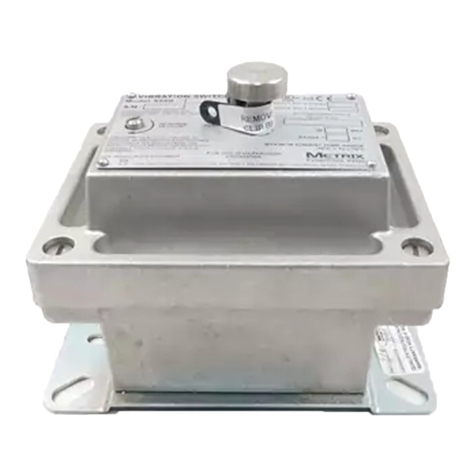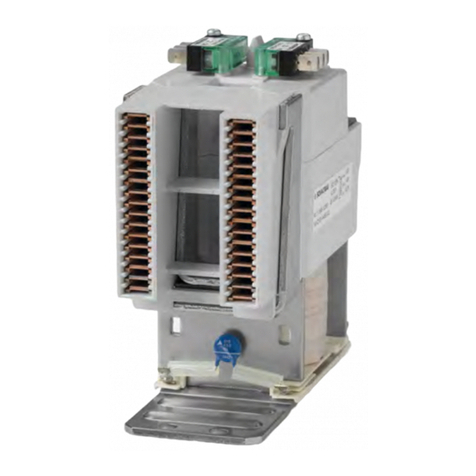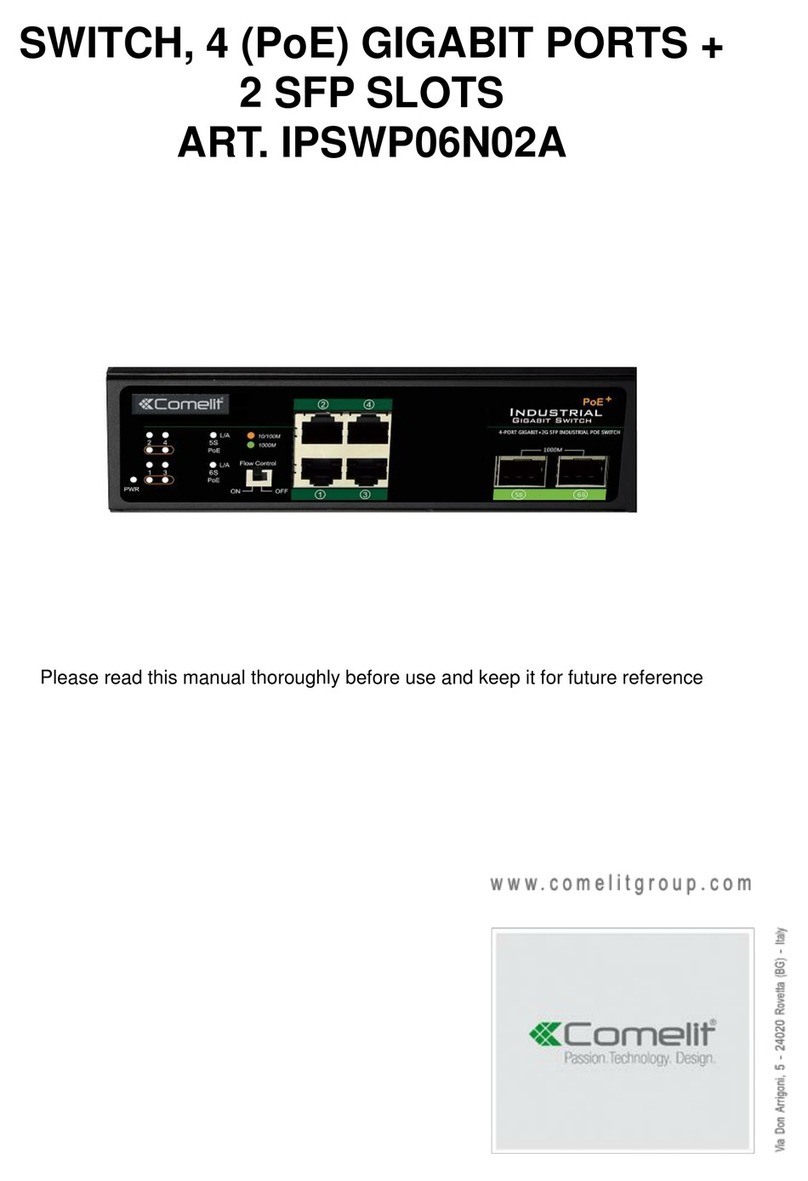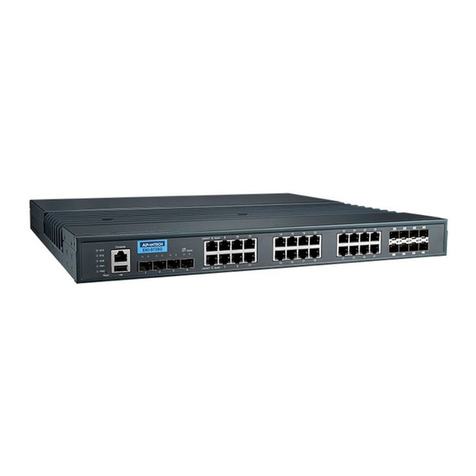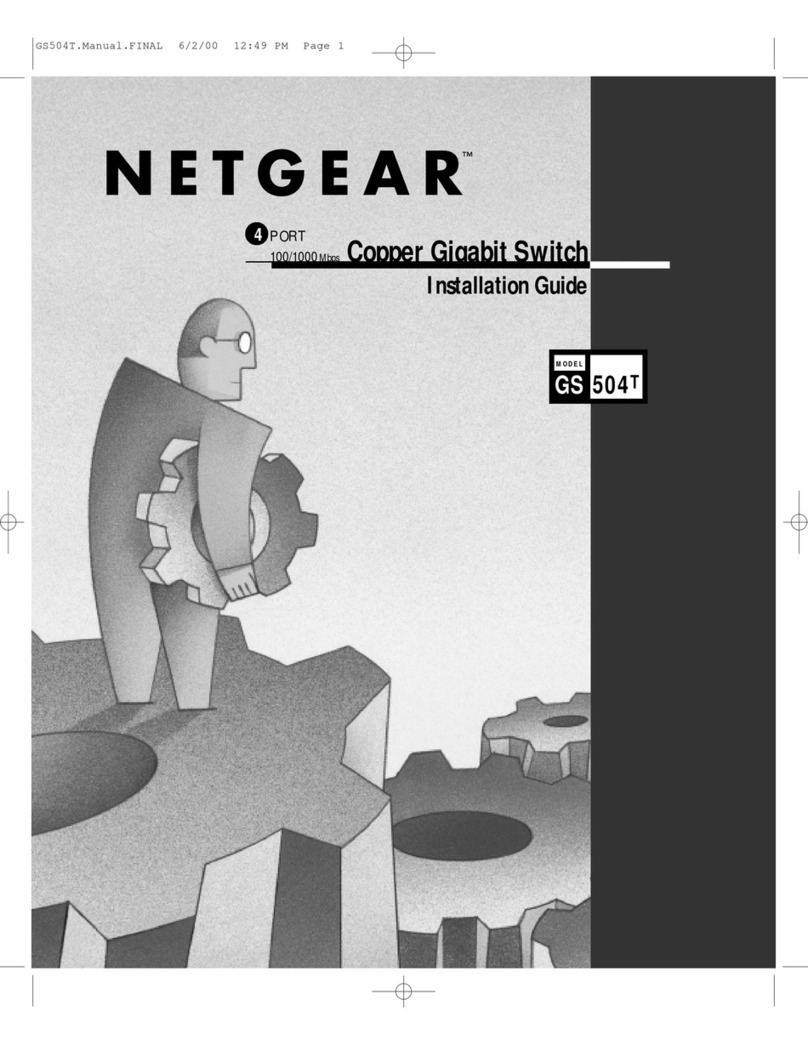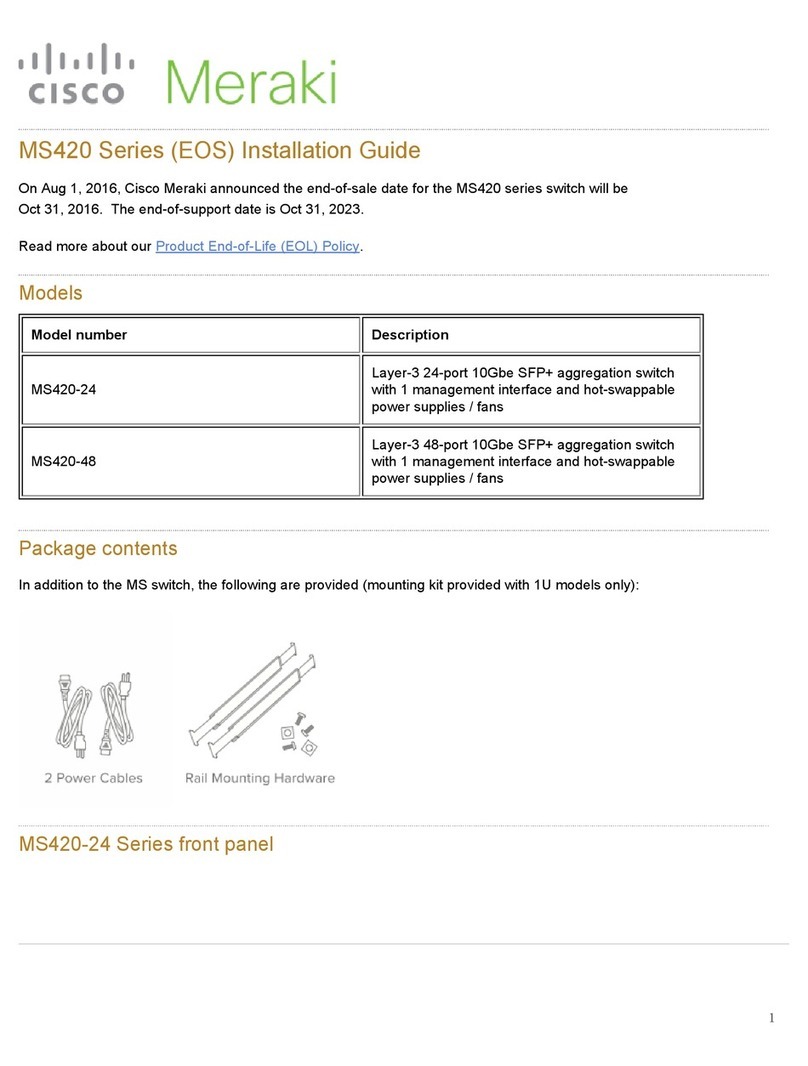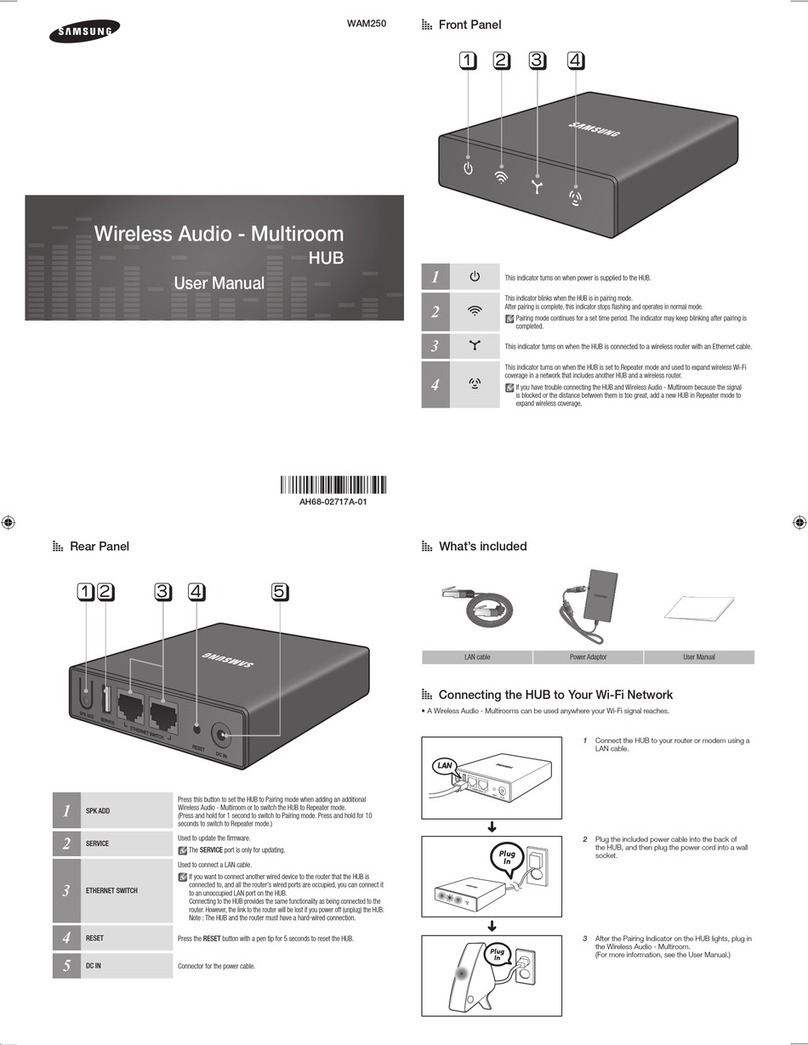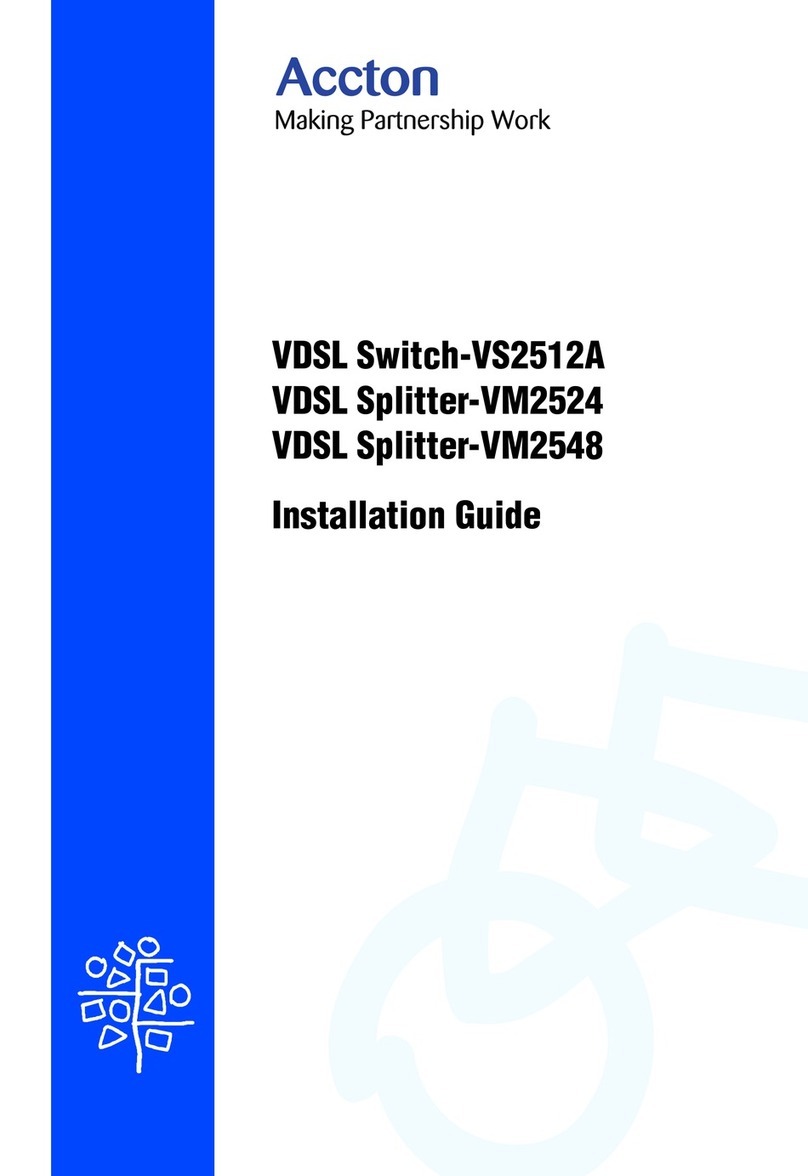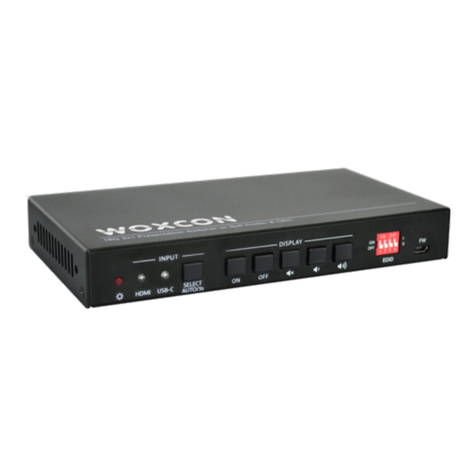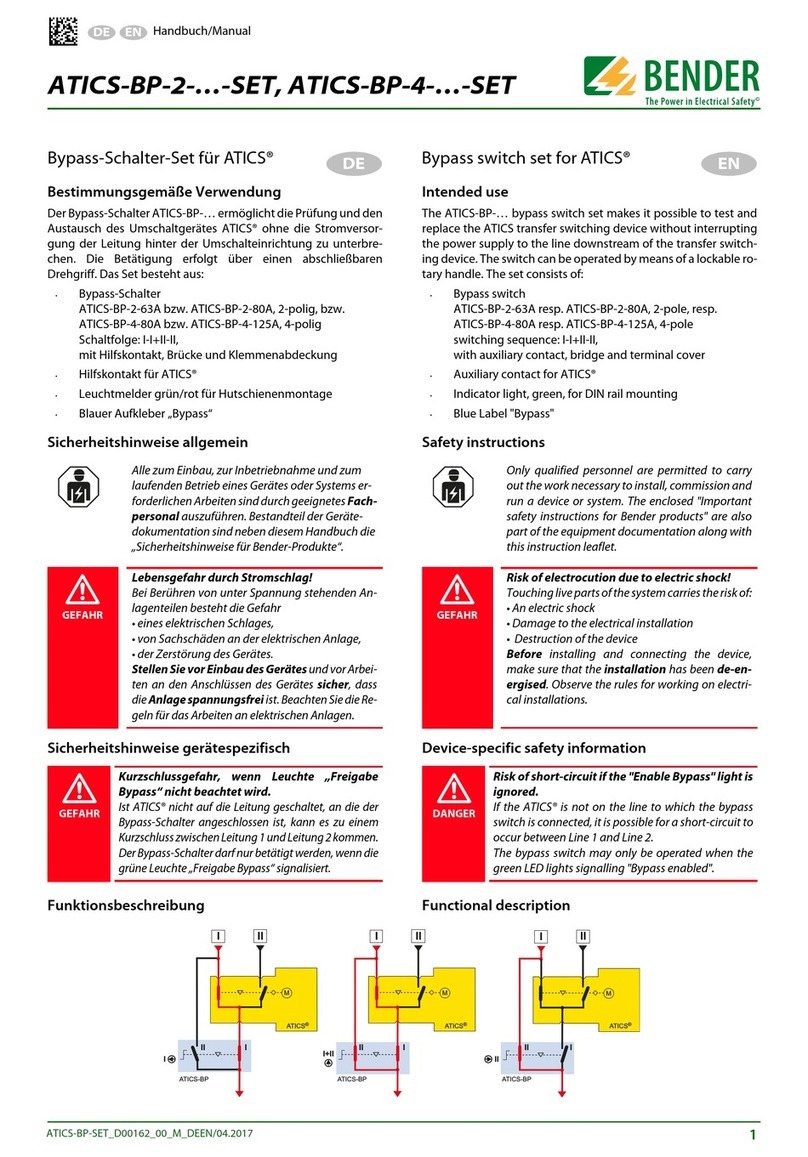Metrix 5550 Instruction Manual

5550 & 5550G MECHANICAL VIBRATION SWITCHES
User Guide / Installaon Manual
DOC# 1231558 • REV C (November 2017)
1180
1180
MODEL 5550
MODEL 5550G
The 5550 and 5550G mechanical vibraon
switches provide vibraon protecon for
low- to medium-speed machinery. An inera
sensive mechanism acvates a snap-acon
switch with SPDT output contacts if the vi-
braon exceeds an adjustable setpoint. The
5550 mechanical vibraon switch contacts
can be used to acvate an alarm or iniate
equipment shutdown. The housing is weath-
erproof with an oponal hazardous area
rang. Electrical (remote) reset with start-up
me delay and a second set of SPDT output
contacts to accommodate DPDT needs
(e.g. separate trip and trip light circuits) are
available.
The 5550G uses idencal internal mecha-
nisms, but carries an IECEX rang ideal for
IIC gas group applicaons.

Doc# 1231558 • REV C (November 2017) Page 2 of 20
1. PRINCIPLES OF OPERATION
1.1 Overview
Model 5550 and 5550G Mechanical Vibraon Switches oer basic protecon against gross
changes in structural seismic acceleraon. The two units are idencal internally and dier
only in their enclosure style and external access to adjustments. The 5550G is used for haz-
ardous area applicaons requiring gas group IIC approvals, but has no externally accessible
adjustments. The 5550 has externally available setpoint adjustment and reset facilies, and
can be used for applicaons up to gas group IIB + hydrogen. Refer to hazardous area instal-
laon manuals M8905 (model 5550) and 100356 (model 5550G) for addional informaon.
The operang mechanism is purely mechanical and
consists of a tension spring aached to a pivong
plate on an over-center fulcrum – magnets are not
employed. Normally, this plate is in an untripped
posion (Figure 1A). However, in the presence of
sucient seismic acceleraon (whether vibratory
or impact), the trip plate will pivot beyond this
over-center posion, snapping to a stable tripped
posion (Figure 1B) where it contacts an internal
micro-switch relay, changing the state of the relay.
This relay is available for external wiring connec-
ons where on/o changes in electrical connuity
can be used to trip the machine and/or annunci-
ate excessive vibraon.
Once the switch has assumed its tripped posion,
it must be reset manually by means of the external
reset plunger (5550 only), or by means of a remote
electrical reset (standard on 5550G, oponal on
5550). The remote reset capability can also be
used as a startup delay to hold the switch in an
untripped state for as long as coil excitaon is sup-
plied – up to 30 seconds (the maximum duraon
is governed by a non-adjustable, factory-installed
thermistor circuit). The startup delay feature is useful during machinery startup when vibra-
on in excess of the normal trip seng may be temporarily incurred.
1.2 Typical Applicaon
The model 5550 and 5550G mechanical vibraon switches are typically used on cooling
tower fans and mounted such that loss of a blade will result in signicant structural accelera-
on at the switch mounng locaon (Figure 2).
The switch may be used on other types of machin-
ery as well, but care must be taken to ensure that
adequate change in acceleraon between “normal”
and “malfuncon” condions will exist at the switch’s
mounng locaon. The switch is not designed to reli-
ably trip for acceleraon levels below approximately
1 g (9.8 m/s2), or when less than 1 g exists between
a machine’s normal running vibraon levels and mal-
funcon vibraon levels. Figure 2: Typical 5550 installaon on
cooling tower fan support strut.
Figure 1A: 5550 mechanical switch trip
mechanism in untripped posion. Micro-
switch (red) is not actuated.
Figure 1B: 5550 mechanical switch trip
mechanism in tripped posion. Micro-
switch (red) is actuated.

Doc# 1231558 • REV C (November 2017) Page 3 of 20
1.3 Primary Variables Aecng 5550 Operaon
The required seismic acceleraon to move the 5550 or 5550G mechanical switch from its un-
tripped posion to its tripped posion is a funcon of three variables as detailed in secons
1.3.1 through 1.3.4.
1.3.1 Variable #1 – Spring Force Direcon
The movable trip plate mass inside the switch housing is
free to move on an essenally friconless pivot, and is
restrained in its untripped posion by a spring. By turning
the setpoint adjustment screw (Figure 3), changes are made
to the spring’s direcon, and to a much lesser extent, its
tension. Thus, the spring mechanism exerts an essenally
constant force on the trip plate and turning the setpoint ad-
justment screw changes the direcon of this force. Turning
the setpoint screw clockwise (CW) aligns the spring force
more fully in the untripped direcon (below the pivot – see
Figure 1), making it more dicult to trip the device. Turn-
ing the setpoint screw counter-clockwise (CCW) does the
opposite, making it easier to trip the device.
SETPOINT
ADJUST
RESET PLUNGER
FIGURE 3: MODEL 5550 setpoint
adjustment and manual reset.
NOTE: Metrix Mechanical Vibraon Switches
are not intended for use on high-speed tur-
bomachinery or on machines where changes in
seismic acceleraon smaller than 1G must be
reliably detected. Instead, Metrix oers more
sophiscated electronic vibraon sensing soluons that
are beer suited for such applicaons.
NOTES:
1. Turning the screw too far in the counter clockwise (CCW) direcon will eventu-
ally pull the spring past the over-center locaon and cause the switch to snap
into the tripped posion without any external ineral excitaon. When adjusted
in this manner, the switch cannot be reset from its tripped posion. Also, the
nature of this over-center mechanism can cause it to be very unstable when adjusted too
close to its equilibrium locaon, resulng in false trips.
2. The setpoint adjustment screw on the model 5550G switch is not externally accessible.
The cover must be removed. Do not remove the cover while energized circuits are pres-
ent in hazardous areas
1.3.2 Variable #2 – Switch Orientaon
Depending on how the switch is oriented, gravity will act on the trip mechanism’s mov-
able mass to either add to or subtract from the spring force. For both model 5550 and
5550G switches, the switch orientaon is the direcon in which the cover faces. With the
switch oriented horizontally (Figure 4A), the eects of gravity will be negligible and only

Doc# 1231558 • REV C (November 2017) Page 4 of 20
FIGURE 4: Side views showing horizontal and vercal orientaons of 5550 switch
NOTE: Depending on how the setpoint is adjusted, sim-
ply turning the switch on its side or upside down may be
sucient to cause it to trip, due to the eects of gravity.
1.3.3 Variable #3 – Vibraon Forces Acng on the Switch
By shaking or impacng the switch along its sensive axis with sucient ineral force for
a sucient duraon and within its frequency response range, the trip plate mechanism
will overcome the combined forces of gravity (depending on orientaon) and spring ten-
sion, snapping from its untripped posion to its tripped posion.
2. INSTALLATION
the spring force will govern the trip plate’s behavior. With the switch oriented vercally
up (Figure 4B), gravity acts to keep the trip plate’s movable mass in the untripped posion,
and ineral excitaon must counteract both gravity and the spring force. With the switch
oriented vercally down (Figure 4C), gravity acts in the opposite direcon and opposes the
spring’s force. Thus, with the same setpoint adjustment, a switch facing up will require the
most excitaon to trip, a switch facing horizontally will require 1g less excitaon to trip, and
a switch facing down will require 2g less excitaon to trip.
WARNING: Before proceeding to wire and install model 5550 and 5550G switch-
es, read and thoroughly understand these instrucons. They are intended for
experienced personnel who require only basic installaon guidance, and assume
that the switch has already been selected and applied properly for the machinery at hand.
When installing the switches in hazardous atmospheres, refer to Metrix manuals M8905
(5550) and 100356 (5550G) for important safety informaon. All of these manuals, as
well as addional technical resources, are available on our website at www.metrixvibra-
on.com. You may also contact Metrix or its local representave for addional assistance,
using the informaon on the last page of this manual.
GRAVITY
SENSITIVE
AXIS
GRAVITY
SENSITIVE
AXIS
GRAVITY
SENSITIVE
AXIS
4A: Horizontal orientaon,
cover facing right
4B: Vercal orientaon,
cover facing up
4C: Vercal orientaon,
cover facing down

Doc# 1231558 • REV C (November 2017) Page 5 of 20
NOTE: When specifying units with 2g reset coil holding
strength simultaneously with a 24 VDC reset coil, do not install
the switch with a horizontal orientaon or upside down. The
reset coil lacks sucient holding force for anything other than
a vercal “face up” orientaon (Figure 4B).
2.1 Maintenance Convenience Versus Measurement Quality
While it is desirable to mount the switch in a locaon in which it can be easily serviced and
maintained, this should not be the dominant consideraon. The switch serves as a me-
chanical sensor and for it to provide suitable machinery protecon, it must be mounted in a
locaon and orientaon where the machine’s ineral forces during malfuncon condions
will be suitably large to trip the switch. Thus, locang the switch for opmal mechanical
sensing – rather than opmal serviceability – must always remain the primary consideraon.
However, in most circumstances, judicious choice of mounng locaon and switch orienta-
on can accommodate both requirements sasfactorily.
2.2 Sensive Axis
The switch is designed to respond to ineral forces only in the direcon of its sensive axis
(Figure 4). When care is not taken to mount the switch properly, relavely large ineral
forces can occur elsewhere on the machine that will not be transmied properly to the
switch, and/or will occur in a direcon perpendicular to the switch’s sensive axis. Both of
these condions can render the switch’s ability to trip less eecve or even ineecve.
2.3 Horizontal Orientaon
A horizontal orientaon of the switch means that it is mounted with its sensive axis per-
pendicular to the direcon of gravity (refer to Figure 4A). In this orientaon, the eects of
gravity on the switch’s trip mechanism are negligible and the trip point is governed almost
enrely by the spring. It is recommended that the switch be oriented horizontally because
most machines are less constrained (less s) in the horizontal direcon than in the vercal
direcon and will therefore vibrate more in the horizontal direcon.
2.4 Vercal Orientaon
A vercal orientaon of the switch means that it is mounted with its sensive axis parallel to
the direcon of gravity. It is not recommended that the switch be oriented vercally (except
as noted above) because most machines are more constrained (more s) in the vercal di-
recon than in the horizontal direcon, and will therefore vibrate less in the vercal direcon.
2.5 Horizontal Machines
Although Figures 5 and 6 both show horizontal switch orientaons, they are not equivalent.
In Figure 5, the sensive axis of the switch points directly at the machine’s sha; in Figure
6, it does not and instead is aimed at point P somewhere above the sha. Either mounng
orientaon can be eecve, but 5 is preferred.

Doc# 1231558 • REV C (November 2017) Page 6 of 20
SHAFT CENTERLINE
CONDUIT
5550 MOUNTING LOCATION
WITH CONDUIT FITTING
FACING DOWN
BASEPLATE
SHAFT Z AXIS
(AXIAL)
CONDUIT
END VIEW
SIDE VIEW
NOTE: A drain hole at low point is
recommended to allow accumulated
moisture to exit (except in
explosion-proof installations)
Shaft Radial YAxis
Shaft Radial XAxis
SHAFT CENTERLINE
SHAFT CENTERLINE
CONDUIT
5550 MOUNTING LOCATION
WITH CONDUIT FITTING
FACING DOWN
BASEPLATE
SHAFT Z AXIS
(AXIAL)
CONDUIT
END VIEW
SIDE VIEW
NOTE: A drain hole at low point is
recommended to allow accumulated
moisture to exit (except in
explosion-proof installations) SHAFT CENTERLINE
P
Shaft Radial YAxis
Shaft Radial XAxis
Figure 5: Horizontal machine showing horizontal 5550 mounng orientaon and preferred locaon.
Conduit ng faces down to allow drainage of any condensaon.
Figure 6: Horizontal machine showing horizontal 5550 mounng orientaon and alternate locaon.
Conduit ng faces down to allow drainage of any condensaon.
Figure 7 shows the same horizontal machine as in Figures 5 and 6, but with the switch ori-
ented vercally. As noted in Secon 2.4, a vercal orientaon of the switch is discouraged
because machines will generally experience less vibraon in the vercal direcon than in
the horizontal direcon, and the switch will be less eecve. Metrix does not recommend
installaon as shown in Figure 7 unless the machine truly experiences more vibraon in the
vercal direcon than in the horizontal direcon, or the 2g / 24V reset coil opon is being
used (see note in Secon 2.4).

Doc# 1231558 • REV C (November 2017) Page 7 of 20
Figure 7: Horizontal machine showing verctal 5550 mounng orientaon (not recommended).
SHAFT CENTERLINE
5550 MOUNTING LOCATION
BASEPLATE
SHAFT Z AXIS
(AXIAL)
CONDUIT
END VIEW
SIDE VIEW
Shaft Radial YAxis
Shaft Radial XAxis
SHAFT CENTERLINE
2.6 Vercal Machines
Figure 8 shows the preferred installaon for a vercal machine. The switch is mounted
horizontally and with its sensive axis poinng directly at the sha.
In contrast, Figure 7 shows the switch mounted vercally, which is not recommended.
Because most vercal machines (like horizontal machines) are rigidly xed by a baseplate
or other mounng that constrains them from vibrang in the vercal direcon, aligning the
switch’s sensive axis in the vercal direcon aligns it in the direcon of least vibraon.
Instead, mount the switch as shown in Figure 5 to ensure that radial (not axial) vibraon is
detected. Mount the switch as shown in Figure 7 only when the machine actually vibrates
more in the vercal than horizontal direcon, or when the 2 g /24 V reset coil opon is used
(see note in secon 2.4).
SHAFT CENTERLINE
CONDUIT
BASEPLATE
5550 MOUNTING LOCATION
WITH CONDUIT FITTING
FACING DOWN
BASEPLATE
SHAFT Z AXIS
(AXIAL)
CONDUIT
TOP VIEW
SIDE VIEW
NOTE: A drain hole at low point is
recommended to allow accumulated
moisture to exit (except in
explosion-proof installations)
Shaft Radial YAxis
Shaft Radial XAxis
Figure 8: Vercal Machine showing horizontal 5550 mounng orientaon and recommended locaon

Doc# 1231558 • REV C (November 2017) Page 8 of 20
2.7 Mounng Rotaon
The switch can be rotated about its sensive axis without aecng its operaon (Figure 9).
Thus, posions 9A, 9B, 9C, and 9D showing the model 5550 switch rotated at 12:00, 3:00,
6:00, and 9:00 posions respecvely do not aect the operaon of the switch and are pri-
marily a maer of preference and serviceability. However, when possible, it is recommend-
ed that conduit ngs be oriented facing down, helping to prevent moisture or condensa-
on accumulaon inside the device.
2.8 Axing The Switch To The Machine
Mount the switch securely to the machine using the 4-hole paern (5550) or 2-hole paern
(5550G) on the baseplate. It is extremely important that the device be rigidly aached
to the machine so that it reects machinery vibraon – not vibraon incurred by a loose
mounng, an insuciently s mounng bracket, or a bracket resonance. Also, the switch
should be mounted in a locaon where its own mass does not appreciably aect the natural
frequency(ies) of the member to which it is aached. When aaching to a support beam,
skid, or other member, thought should be given to the usefulness of the measurement and
what level of machinery damage must be present before sucient acceleraon will occur at
the measurement locaon. For addional applicaon assistance, consult the factory or your
nearest Metrix representave.
2.9 Wiring
The switch provides a single SPDT relay or oponal double SPDT relays, allowing use as a
DPDT device. When a reset / startup delay coil is specied (oponal on 5550; standard on
5550G), suitable wiring terminals are also available. Refer to Figure 10 for wiring terminal
assignments.
9A - 12:00 horizontal orientaon
9B - 3:00 horizontal orientaon
9C - 6:00 horizontal orientaon
9D - 9:00 horizontal orientaon (preferred)
Figure 9: Horizontal orientaons of 5550. 9D posion is strongly recommended
(conduit hole facing down) to allow drainage oof any accumulated condensaon.
GRAVITY

Doc# 1231558 • REV C (November 2017) Page 9 of 20
When wiring the device, observe the following:
2.9.1 Do not exceed switch contact rangs listed on the nameplate.
2.9.2 Comply with all applicable electrical codes.
2.9.3 Keep eld wiring away from the moving parts of the trip plate mechanism.
2.9.4 All power must be switched o before opening the enclosure in an explosive
atmosphere.
2.9.5 The switch must be electrically connected by means of a ameproof/dust cable
gland or stopping box cered to IEC60079-0:2011 (EN60079-0:2012), IEC60079-1:2007
(EN60079-1:2007), and IEC600079-31:2008 (EN60079-31:2009).
2.9.6 For ambient temperatures below -10°C, use eld
wiring suitable for the minimum ambient temperature.
2.9.7 Reinstall the cover by rst ensuring the o-ring
is in place and properly seated in the housing’s groove.
Place the cover on the unit and screw ght (model
5550G) or by torqueing the four cover bolts shown in
Figure 11 (model 5550 only) to 6-7 /lbs.
NOTE: It is not recommended
that wiring be connected to the
device unl aer verifying the
factory default setpoint in Secon
4.1 and performing the in-situ setpoint
adjustments in Secon 4.2. This will pre-
vent having to disconnect the wiring and
remove the device from its mounng loca-
on. It will also prevent unwanted trips
while inially adjusng the setpoint.
WARNING: Voltages present at
switch terminals can result in
serious injury or death. Always
de-energize these circuits prior
to installaon or maintenance and use
appropriate lock-out / tag-out proce-
dures where applicable.
CAUTION: If eld wiring is allowed to obstruct the
moving parts of the switch, it may prevent the trip
plate from operang correctly. Machinery protec-
on can be compromised and serious machinery damage
and/or personnel injury may result.
NOM
OPEN
COM
NOM
CLOSED
RESET COIL
CASE
RESET COIL
L(+)
N(-)
GRN
NOM
OPEN
COM
NOM
CLOSED
RESET COIL
CASE
RESET COIL
L(+)
N(-)
GRN
NOM
OPEN
COM
NOM
CLOSED
WIRING DIAGRAM
SPDT DPDT
DPDT CONTACTS AND RESET COIL OPTION
Figure 10: Wiring connecons
Figure 11: 5550 cover bolts locaon
2
1
3
4

Doc# 1231558 • REV C (November 2017) Page 10 of 20
2.10 Conduit: When aaching conduit, observe the following:
2.10.1 Avoid long runs of unsupported conduit that can transfer unwanted impacts or
vibraon of the conduit, rather than of the machine.
2.10.2 Always slope conduit away from the switch and generally orient such that accumu-
lated moisture or condensaon does not drain into the switch. For non-explosion proof
installaons, consider the use of an adequate number of J-traps or other drain mecha-
nisms at low points to preclude moisture from collecng in the switch or in the conduit.
When possible, mount the switch so that the conduit outlet faces down.
2.10.3 Units with NPT conduit holes (ordering opon E=1, 2, 3, 7) have ¾” NPT threads.
Units with metric conduit holes (ordering opon E=4, 6, and 8) have M20 x 1.5 threads.
Refer to Metrix datasheet # 1004461 for a complete list of ordering opons.
2.10.4 Use proper conduit seals and hole plugs meeng the environmental requirements
of the installaon to prevent ingress of moisture and dust.
2.11 Protecng Against Moisture Ingression
All installaons should observe the guidelines of 2.10. These are parcularly important
when the switch will be mounted in moist environments such as on cooling tower struc-
tures, evaporave fans, marine applicaons, or other installaons where the switch will be
exposed to rain, elevated humidity, hose-directed water, or any environmental condions
that might allow condensaon to form at or in the switch, associated wiring, and conduit.
2.11.1 Ensure the cover is properly ghtened
The importance or properly ghtening cover bolts (5550) or screw-type lid (5550G) per-
tains not just to sealing against ignion of a ammable atmosphere outside the switch,
but also to prevent dust or moisture ingression to the switch internals.
2.11.2 Examine Cable Insulaon for Nicks and Cuts
In some cases, properly rated cable may be installed without solid or exible conduit to
NOTE: The disposable plasc plugs that ship in each con-
duit hole provide only physical thread protecon during
shipping and handling. They are not designed for use as
permanent hole plugs and do not provide adequate environ-
mental protecon for the switch when installed in the eld.
CAUTION: Do not over-torque or under-torque
housing screws. Over torqueing can damage the
housing and compromise the seal. Under torque-
ing can permit moisture to weep into the switch. Either
condion can compromise switch operaon and/or present
an electrical shock hazard.
NOTE: Do not over-torque the cover bolts on the model 5550
switch. This could damage the housing and compromise the seal.

Doc# 1231558 • REV C (November 2017) Page 11 of 20
preclude it as a potenal source of moisture collecon. However, whether installed with
or without conduit, all cables should be examined for nicks and cuts that compromise the
protecve outer jackeng. In parcular, mul-conductor cables can act as very eecve
wicks when the outer jacket has been cut or damaged. Once moisture ingresses into the
cable, it will oen nd its way into the switch via this wicking mechanism, even when an
appropriate gland seal is used at the switch’s conduit opening and the outer periphery of
the cable is not leaking at the gland.
2.11.3 Liberally Apply Silicone Dielectric Grease to all Openings
The primary points of moisture entry into the switch are where the housing is penetrated:
- The setpoint adjustment screw (5550 only)
- The reset plunger (5550 only)
- The conduit ng(s)
- The seal between housing body and housing cover
O-ring seals and gaskets are used at each of these entry points and silicone dielectric
grease is applied at the factory. However, in extremely moist environments an addional
liberal coang of silicone dielectric grease should be applied in the eld at me of
installaon. This pracce will provide added protecon against moisture ingression
over me. Metrix recommends Dow Corning #33 Molykote® Extreme Low Temperature
Silicone Grease or equivalent.
2.12 Outline Diagrams and Physical Dimensions
Refer to the Metrix product datasheet # 1004461, available at www.metrixvibraon.com
3. IMPORTANT SAFETY INFORMATION
3.1 General Safety Summary
Review the following safety precauons to avoid injury and prevent damage to this product
or any products connected to it.
• USE ONLY AS SPECIFIED
To avoid potenal hazards, use this product only as specied. Only qualied personnel
should perform installaon and removal procedures.
• CONNECT AND DISCONNECT PROPERLY
Do not connect or disconnect this product while it is connected to a live power source.
• GROUND THE PRODUCT
The housing of this product should be connected to earth ground. Before energizing the
product, ensure its housing is properly grounded.
• OBSERVE ALL TERMINAL RATINGS
To avoid re or shock hazard, observe all rangs and markings on the product. Consult
the individual secons of this manual for further informaon before making connecons
to the product.
• DO NOT OPERATE WITHOUT COVER
The cover serves mulple purposes that may include protecon against moisture and
dust ingression, protecon of personnel from electrical shock, and protecon against

Doc# 1231558 • REV C (November 2017) Page 12 of 20
ignion of ammable atmospheres when used in locaons with hazardous area rangs.
Do not use the device without its cover except when making adjustments or connecons
as noted in this manual.
• AVOID EXPOSURE TO CIRCUITRY
Do not touch exposed electrical connecons and components when power is present.
• DO NOT OPERATE WITH SUSPECT FAILURES
If you suspect there is damage to this product, have it inspected by qualied personnel.
3.2 Safety Terms and Symbols
Terms that appear in this manual requiring special aenon include:
• WARNING: Warning statements idenfy condions or pracces that could result in
injury or loss of life.
• CAUTION: Cauon statements idenfy condions or pracces that could result in
damage to the product, loss or corrupon of data, or damage to the environment or
other property.
• NOTE: Notes idenfy material of special interest or importance to the user, not includ-
ing cauons or warnings.
Symbols that may appear on the product and/or in this manual include:
• HIGH VOLTAGE PRESENT
• DANGER or CAUTION
4. SETPOINT ADJUSTMENT
Metrix mechanical vibraon switches are shipped from the factory such that when slowly
rotated 180 degrees from an upright posion (cover facing up) to an upside down posion
(cover facing down), the trip plate will snap from its untripped posion to its tripped posi-
on.
4.1 Vericaon of Factory Setpoint
To verify the factory setpoint, place the switch on a at surface with the cover facing up.
Do not connect any wiring yet. Press the reset plunger (model 5550 only – remove cover
on model 5550G) to ensure the switch is in its untripped posion (it may have tripped due
to shock or vibraon incurred during shipping and handling). Then, slowly li the switch
• PROTECTIVE EARTH
• FUNCTIONAL GROUND
• NOTE

Doc# 1231558 • REV C (November 2017) Page 13 of 20
CAUTION: The default setpoint as shipped from the factory is
not intended to be suitable for any parcular machinery appli-
caon. Each applicaon requires that the setpoint be careful-
ly eld adjusted for the specics of your machine as outlined in Secon
4.2 below. Failure to adjust the setpoint in this manner constutes a
misuse of the product and may lead to ineecve machinery protecon
resulng in extensive machinery damage and personnel injury.
up and rotate it to an upside down posion as shown in Figure 12. As the switch reaches
the 180-degree posion, you should hear an audible “click” indicang it has snapped to its
tripped state. If the device does not trip, turn the setpoint adjustment screw approximately
1/16th turn CCW and repeat the above procedure. Connue adjusng in 1/16th CCW turn
increments unl the unit trips when turned from right side up to upside down. When per-
forming this vericaon on the Model 5550G, it is recommended that you leave the cover
o. The presence or absence of the cover does not aect the setpoint during the vericaon
process and ensures the cover does not have to be repeatedly removed and reinstalled to
adjust the setpoint and reset the trip plate. However, never remove the cover with ener-
gized wiring connected – remove power before opening cover.
NOTE: If the switch will not
reset, adjust the setpoint screw
1/8th turn CW and press the
reset buon. Repeat this pro-
cedure, adjusng 1/8th of a turn each
me, unl the device can be reset.
While performing this procedure,
keep the device sing on a at sur-
face with the cover side facing up.
4.2 In-Situ Setpoint Adjustment
The setpoint adjustment is accessible externally on the model 5550 (see Figure 3). For model
5550G, the lid must be removed. Follow the steps below to adjust the setpoint for the par-
culars of your machine.
4.2.1 Verify the factory setpoint as described in 4.1 above. Then, rotate the adjustment
screw one full turn (360 degrees) clockwise and proceed to step 4.2.2.
4.2.2 Install the switch on the machine following the guidelines of secon 3. Ensure
the eld wiring is disconnected. If it has already been connected, disconnect temporarily,
Figure 12: Verifying the factory default
setpoint on the 5550

Doc# 1231558 • REV C (November 2017) Page 14 of 20
NOTE: The objecve is to establish a setpoint as close as possible to
normal operang condions, while sll allowing normal uctuaons
in speed, load, ow, etc. without false trips. Establishing a setpoint
that is too high may render machinery protecon ineecve. DO NOT at
this me aempt to adjust the setpoint for high vibraon encountered
during machine startup. This will be addressed in step 4.2.11.
taking appropriate cauons around any wiring that is (or may become) energized during
machine starng sequences and the setpoint adjustment procedure.
4.2.3 Reset the switch by depressing the reset plunger (5550) or manually pushing the
exposed trip plate into its untripped posion (5550G).
4.2.4 Connect a connuity tester or ohmmeter across COM & NOM OPEN terminals
(refer to Figure 10). This will allow you to visually conrm when the normally open relay
contacts close, indicang the switch has tripped. This is also true for COM & NOM CLOSE,
the normally closed relays contacts open when tripped.
4.2.5 Hold the reset plunger (5550) or trip plate (5550G) down and start the machine.
When the machine has reached running speed, release the plunger (5550) or trip plate
(5550G).
4.2.6 If the switch trips when releasing the plunger/trip plate, rotate the setpoint screw
a full turn (360 degrees) CW and then depress the plunger/trip plate, holding it in the
untripped posion. Release the plunger/trip plate once again and watch to see if the
switch trips. Repeat this process unl the switch does not trip with the machine running
at normal operang speed. Then, proceed to step 4.2.7.
4.2.7 With the machine running, SLOWLY turn the setpoint adjustment screw CCW unl
the switch trips. Then, turn the screw in the opposite direcon (CW) 1/8th turn, or ac-
cording to OEM instrucons, and reset the switch.
4.2.8 Allow the machine to run for as long as necessary to ensure the switch does not
trip under normal speed, load, and other operang condion changes. If the switch does
not trip, proceed to step 4.2.10. If it trips, proceed to step 4.2.9.
4.2.9 (Perform this step only if the switch tripped in step 4.2.8.) Turn the setpoint
adjustment screw in the CW direcon (increasing setpoint) in the smallest increment pos-
sible – preferably 1/16th turn or less, or according to OEM instrucons. Reset the switch
and repeat step 4.2.8.
NOTE: This step accomplishes two objecves. First, it allows the in-
staller to easily ascertain when the switch has snapped from its un-
tripped state to its tripped state, as it may be dicult or impossible
to listen for an audible “click” in the presence of ambient machine noise.
Second, it allows appropriate setpoint adjustments to be made without
unnecessary trips of the machine (repeated starts/stops on a machine are
usually undesirable and may be electrically and/or mechanically damaging
in some circumstances).

Doc# 1231558 • REV C (November 2017) Page 15 of 20
4.2.10
4.2.11 You have now established your unique setpoint and no further adjustment is
required. If the switch was supplied with an oponal reset / startup delay coil, connect all
eld wiring and proceed to secon 5. If the switch was not supplied with this coil, proceed
to step 4.2.11 to determine whether a startup delay is needed for your applicaon.
4.2.12 Stop the machine, press the reset plunger pushbuon to ensure the switch is in its
untripped state, and then restart the machine. If the switch does not trip during machine
startup, you do not require a startup delay. Connect all eld wiring and place the switch
into service. If it does trip due to elevated vibraon levels during startup, you will require
an appropriate startup delay coil (see secon 5). Consult the factory or your nearest
Metrix representave for assistance.
5. ELECTRICAL RESET AND STARTUP DELAY
When a reset coil is specied (standard on 5550G, oponal on 5550 where ordering opon D
= 1, 2, 3, or 4), an electrical solenoid mechanism is installed that allows remote reset of the
switch when in its tripped posion, and iniaon of a startup delay when in its untripped
posion. To acvate these features, the rated voltage must be applied to the reset coil wir-
ing terminals (refer to Figure 10). The reset funcon requires only momentary applicaon of
voltage. The startup delay funcon requires connuous applicaon of voltage for the dura-
on of the factory pre-set me delay (approximately 20-30 seconds).
5.1 Electrical (Remote) Reset
This feature allows remote reset of the switch from its tripped posion. To acvate,
momentarily apply the rated voltage across the appropriate terminals (refer to Figure 10),
taking care to observe the polarity. The applicaon of this voltage will energize the solenoid
mechanism, extending its plunger and reseng the switch to its untripped posion. Once
the solenoid has reset the switch, voltage can be removed. The switch will remain in its
untripped posion unl sucient acceleraon trips it.
5.1.1 Connuous Bypass
It is not possible to connuously bypass the switch using the reset funcon. A connu-
ous voltage across the reset terminals will acvate the startup delay feature lasng
approximately 20-30 seconds, aer which the switch will return to normal operaon. If a
connuous bypass funcon is required, an isolaon switch should be installed in the same
NOTE: If more than one full turn of the setpoint screw is re-
quired to accommodate variaons in normal running condions
without false trips, the 5550 may not be an appropriate device
for your applicaon. Contact the factory for assistance.
CAUTION: The switch’s setpoint must be established relave
to normal machinery operaon, not startup vibraon levels.
DO NOT adjust the setpoint screw to increase the switch’s
trip point if the machine trips due to high vibraon during startup.
The startup delay feature (oponal on 5550 – standard on 5550G) is
specically designed to suppress the switch from tripping for a pre-set
interval during startup. Elevang the setpoint to accommodate start-
up vibraon levels can result in missed trips during genuine machinery
malfuncon condions, and constutes a misuse of the switch.

Doc# 1231558 • REV C (November 2017) Page 16 of 20
NOTE: The reset coil circuit contains a thermistor that allows the circuit to
also funcon as a startup delay when voltage is connuously applied (see
secon 5.2). If the thermistor is hot, current will not ow and the reset
funcon will not operate. A cool-down period may be required (see Secon
5.2.1). In many applicaons, voltage is connuously applied to the reset coil ter-
minals while the machine is running. In such situaons, the thermistor will sll be
hot immediately following a trip and it will not be possible to electrically reset the
switch unl the thermistor has cooled suciently. If necessary, the switch can be
manually reset (5550 only), using the plunger pushbuon to allow a “hot” restart.
Alternavely, it may be desirable to program the machine’s control system to ap-
ply voltage to the reset coil for only 30 -40 seconds during machine start up. This
pracce will ensure that the thermistor is more likely to be “cold” following a trip,
allowing an immediate remote reset.
circuit as the output relay(s), allowing the 5550/5550G to be removed from the machinery
shutdown loop.
5.2 Startup Delay
The startup delay feature is intended for use in machines that exhibit high vibraon during
startup. This feature maintains the switch in an untripped posion for a factory pre-set
delay period of approximately 30 seconds, aer which the switch resumes normal operaon.
To acvate startup delay, connuously apply the specied voltage across the reset terminals
and the switch will be suppressed from tripping for the preset delay period, allowing the
machine to run up to operang speed and normal vibraon levels. Voltage must be connu-
ously applied for the duraon of the startup delay (approximately 30 seconds). If this volt-
age is removed prematurely, the coil will de-energize and the switch will not be suppressed
from tripping.
5.2.1 Thermistor Consideraons
The startup delay feature works through use of an internal thermistor in series with a sole-
noid mechanism. When voltage is connuously applied, current ows in the circuit and the
thermistor’s temperature rises, gradually restricng current ow. When the current drops
below the minimum value required to keep the coil energized, the solenoid retracts. Nor-
mally, it takes approximately 30 seconds for the thermistor to reach this “cut-o” tempera-
ture. However, several factors can serve to shorten or lengthen this interval as follows:
• Ambient Temperature Eects
The me for the thermistor to reach its cut-o value depends on the inial temper-
ature of the thermistor. If the switch is at an ambient temperature of -30C during
the winter months, it will obviously exhibit a longer startup delay than during the
summer months when ambient temperatures may be 30C. Likewise, if the switch is
placed on a machine that can sustain a large temperature rise at the mounng loca-
on, the switch may be near its maximum temperature rang of 70C aer a period
of prolonged operaon. This will shorten the startup delay interval when compared
to operaon on a “cold” machine.
WARNING: Voltages present at reset terminals can result
in serious injury or death. Always de-energize these
circuits prior to installaon or maintenance and use ap-
propriate lock-out / tag-out procedures where applicable.

Doc# 1231558 • REV C (November 2017) Page 17 of 20
• Cool-Down Period
If the circuit acvang the startup delay leaves the voltage connuously applied (as
is typical), the thermistor will remain hot unl voltage is removed, such as follow-
ing a machine trip. Thus, when the thermistor is not allowed to cool to its ambient
surroundings, it will shorten the startup delay.
• Immediate Restart
If a restart is required immediately following a trip, the thermistor may be so hot
that the switch cannot be immediately reset using the remote reset funcon. In
such situaons, it will be necessary to either manually reset the switch or wait for
the thermistor to cool suciently. Alternavely, it may be desirable to modify the
machinery control logic such that voltage is only applied to the reset terminals for
the duraon of the factory pre-set delay, ensuring that the thermistor circuit is only
energized at startup.
• Current Flow
The amount of current owing through the thermistor will be a funcon of the volt-
age applied, the thermistor’s resistance, and the resistance elsewhere in the circuit.
Loose, intermient, or corroded wiring connecons can increase resistance and result
in a longer startup delay interval. If the resistance is too great, the reset coil will not
energize at all due to insucient current. Insucient voltage and/or current can also
be a problem. Be certain that the coil voltage rang (ordering opon D) matches the
voltage and current your circuit supplies. See Table 1 on the following page.
Opon D
(coil voltage)
Opon C
(coil holding
force)
Rated
Voltage
Min
Voltage
Max
Voltage
Min
Current
Max Power
Consumpon
None (D=0) All N/A N/A N/A N/A N/A
115 Vac (D=1) All 115 Vac 103.5 Vac 126.5 Vac 1.24 A 287.5 W
230 Vac (D=2) All 230 Vac 207 Vac 253 Vac 0.32 A 230 W
24 Vdc (D=3) 5 g (C=1) 24 Vdc 22.8 Vdc 25.3 Vdc 1.58 A 60 W
2 g (C=2) 24 Vdc 22.8 Vdc 25.3 Vdc 1.18 A 28.8 W
10 g (C=3) 24 Vdc 22.8 Vdc 25.3 Vdc 2.88 A 72 W
115 Vdc (D=4) All 115 Vdc 103.5 Vdc 126.5 Vdc 1.20 A 207 W
Table 1: Reset / Startup Delay Coil Electrical Characteriscs
5.3 Coil Consideraons
5.3.1 Coil Hold Strength
The reset / startup delay coil is sized to provide a specied holding strength (opon C), al-
lowing the startup delay feature to hold the switch in its untripped state even in the pres-
ence of high vibraon encountered during machine startup. If the reset coil supplied will
not hold the switch in an untripped state during startup, it may be the wrong size. Refer
to Table 1 and consult the factory for assistance.

Doc# 1231558 • REV C (November 2017) Page 18 of 20
NOTE: The 24 VDC reset coil comes in three dierent versions,
depending on the holding strength opon specied (opon C).
Although each has the same min/max voltage rang, the current
draw will be larger for larger holding coil strengths, as noted in Table 1. Be
certain your power source for this coil is capable of supplying the neces-
sary current for the rated holding strength.
5.3.2 Duraon Consideraons
The duraon of the startup delay (approximately 30 seconds) is factory set and cannot
be altered. With the switch in an untripped state, connuous applicaon of the specied
voltage to the reset terminals will iniate the delay feature, but will not cause it to persist.
That is, applying a connuous voltage across the reset terminals for longer than 20-30
seconds does not allow one to arbitrarily increase the duraon of the startup delay. See
secon 5.2.1 for a more in-depth explanaon of the circuit operaon.
6. DRAWINGS, SPECIFICATIONS, AND ORDERING INFORMATION
Unless otherwise noted, all gures and illustraons in this manual depict the model 5550
mechanical switch. The 5550G is idencal in terms of its internal mechanisms, but has a
dierent housing that is rated for use in the more stringent IIC gas group. For addional in-
formaon on models 5550 and 5550G, including outline diagrams, Metrix specicaons, and
ordering informaon, refer to Metrix product datasheet # 1004461. Refer also to hazardous
area installaon manuals M8905 (5550) and 100356 (5550G) as appropriate.

Doc# 1231558 • REV C (November 2017) Page 19 of 20
7. HAZARDOUS AREA APPROVALS
MODEL 5550
IECEx Approval
(World):
IEC Markings:
Ex d IIB + H2 T6 Gb
Ex tb IIIC T85°C Db Ta -40°C to
+70°C IP66
IECEx BAS10.0020
IEC Standards:
IEC60079-0:2011
IEC600079-1:2007
IEC600079-31:2008
CAUTION: TO REDUCE
RISK OF IGNITION OF
HAZARDOUS ATMO-
SPHERES, DISCONNECT
THE SUPPLY CIRCUIT
BEFORE OPENING. KEEP
ASSEMBLY TIGHTLY
CLOSED WHEN IN
OPERATION. CABLE
TEMPERATURE RISE 15K
- U S E S U I T A B L E C A B L E .
ATTENTION: AFIN
DE PREVENTIR
L-INFLAMMATION
D’ATMOSPHERES
DANGEREUSES COUPER
L’ALIMENTATION ELEC-
TRIQUE CIRCUIT AVANT
D’OUVRIR COFFRET
GARDER LE COUVERCLE
BIEN FERMETANT QUE
LES CIRCUITS SONT
SOUS TENSION. TEM-
PERATURE DE CABLE
MONTE 15K - UTILISEZ
CABLE APPROPRIE.
ATEX Approval
(Europe):
ATEX Markings:
II 2GD Ex d IIB + H2 T6 Gb
Ex tb IIIC T85°C Db Ta -40°C to
+70°C IP66
Baseefa 10ATEX0098
EN Standards:
EN60079-0:2012
EN60079-1:2007
EN60079-31:2009
UL Approval
(North
America):
UL Markings:
Models 5550-2XX-XXX or
5550-7XX-XXXZ:
Class I, Div 1, Groups B,C,D,Class
II, Div 1,
Groups E,F,G, Type 4 or 4X, IP66
Models 5550-1XX-XXX or
5550-6XX-XXX:
Class I, Div 1, Groups C,D,Class
II, Div 1,
Groups E,F,G, Type 4 or 4X, IP66
UL/CSA Standards:
UL 698
UL 508
CSA C22.2 No. 25
CSA C22.2 No. 30
CSA C22.2 No. 14
1180

Doc# 1231558 • REV C (November 2017) Page 20 of 20
This electronic equipment was manufactured according to high quality stan-
dards to ensure safe and reliable operaon when used as intended. Due to its
nature, this equipment may contain small quanes of substances known to be
hazardous to the environment or to human health if released into the environ-
ment. For this reason, Waste Electrical and Electronic Equipment (commonly
known as WEEE) should never be disposed of in the public waste stream. The
“Crossed-Out Waste Bin” label axed to this product is a reminder to dispose of this product
in accordance with local WEEE regulaons. If you have quesons about the disposal pro-
cess, please contact Metrix Customer Service.
ENVIRONMENTAL INFORMATION
info@metrixvibraon.com
www.metrixvibraon.com
8824 Fallbrook Dr. Houston, TX 77064, USA
Tel: 1.281.940.1802 • Fax: 1.713.559.9421
Aer Hours (CST) Technical Assistance: 1.713.452.9703
MODEL 5550G
IECEx Approval
(World):
IEC Markings:
Ex d I IC T6 Gb
Ex tb IIIC T85°C Db Ta
-40°C to +70°C IP66
IECEx BAS10.0095X
IEC Standards:
IEC60079-0:2011
IEC600079-1:2007
IEC600079-31:2008
CAUTION: TO REDUCE RISK
OF IGNITION OF HAZARDOUS
ATMOSPHERES, DISCONNECT THE
SUPPLY CIRCUIT BEFORE OPENING.
KEEP ASSEMBLY TIGHTLY CLOSED
WHEN IN OPERATION. CABLE
TEMPERATURE RISE 15K - USE
S U I TA B L E C A B L E .
ATTENTION: AFIN DE PRE-
VENTIR L-INFLAMMATION
D’ATMOSPHERES DANGEREUSES
COUPER L’ALIMENTATION ELEC-
TRIQUE CIRCUIT AVANT D’OUVRIR
COFFRET GARDER LE COUVERCLE
BIEN FERMETANT QUE LES
CIRCUITS SONT SOUS TENSION.
TEMPERATURE DE CABLE MONTE
15K - UTILISEZ CABLE APPROPRIE.
ATEX Approval
(Europe):
ATEX Markings:
I I 2 G D E x d I I C T 6 G b
Ex tb IIIC T85°C Db Ta
-40°C to +70°C IP66
B a s e e f a 1 0 A T E X 0 1 7 7
EN Standards:
EN60079-0:2012
EN60079-1:2007
EN60079-31:2009
1180
Other manuals for 5550
2
This manual suits for next models
1
Table of contents
Other Metrix Switch manuals
Popular Switch manuals by other brands
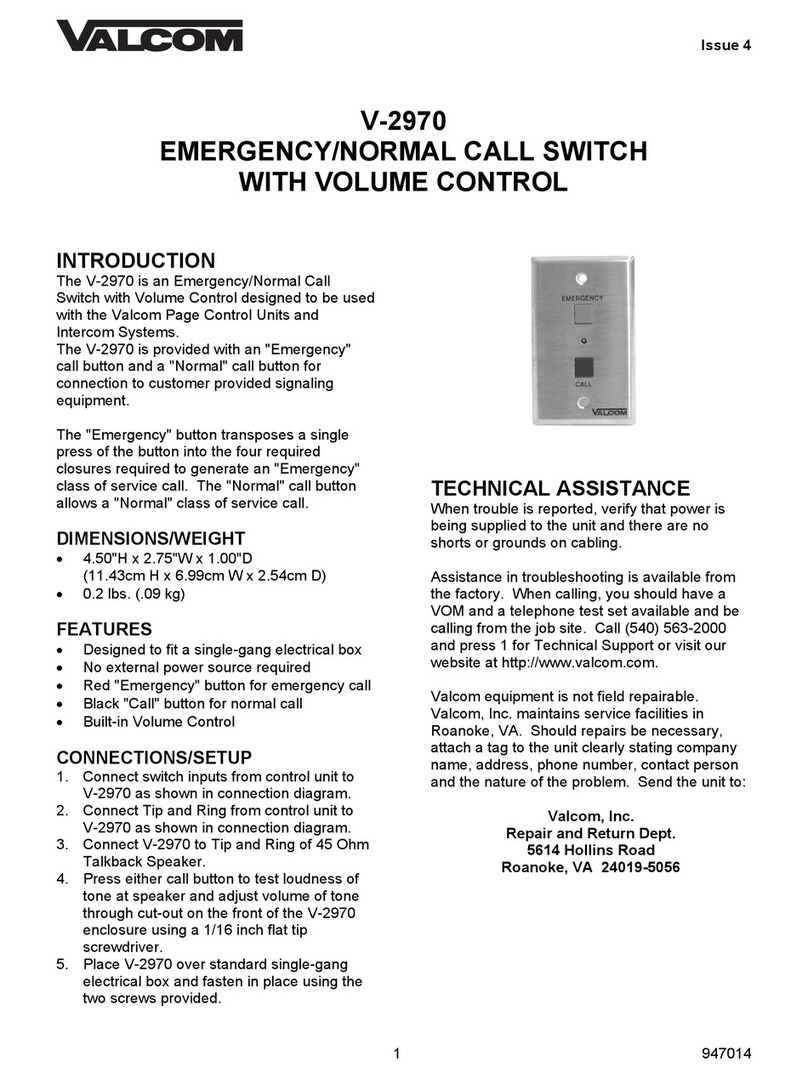
Valcom
Valcom V-2970 instruction manual

MyNetFone
MyNetFone MNF VPBX quick start guide
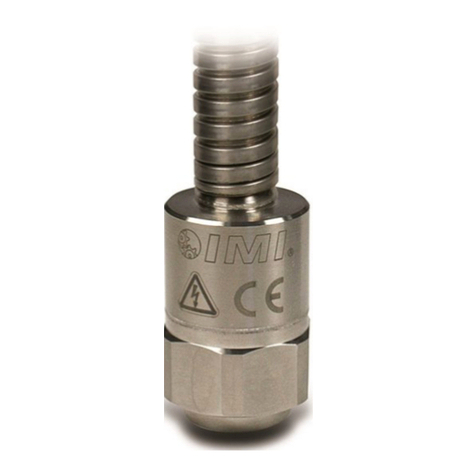
PCB Piezotronics
PCB Piezotronics IMI Sensors 686B61 Installation and operating manual
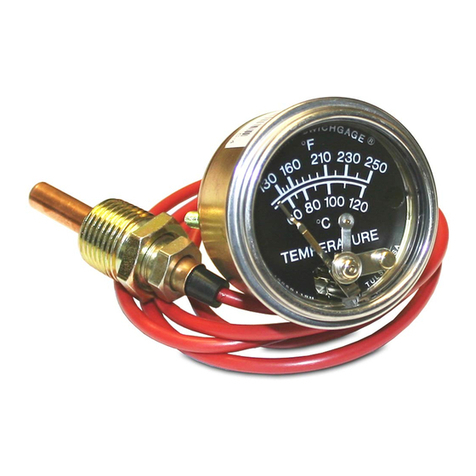
Murphy
Murphy Temperature SWICHGAGE A20 Series owner's manual
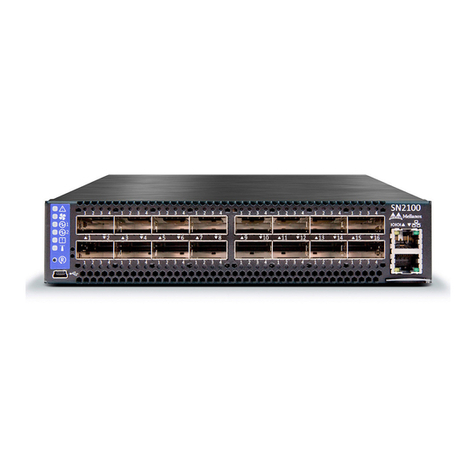
Mellanox Technologies
Mellanox Technologies Spectrum SN2100 Quick installation guide

Ultra
Ultra GammaView 2555 user manual
